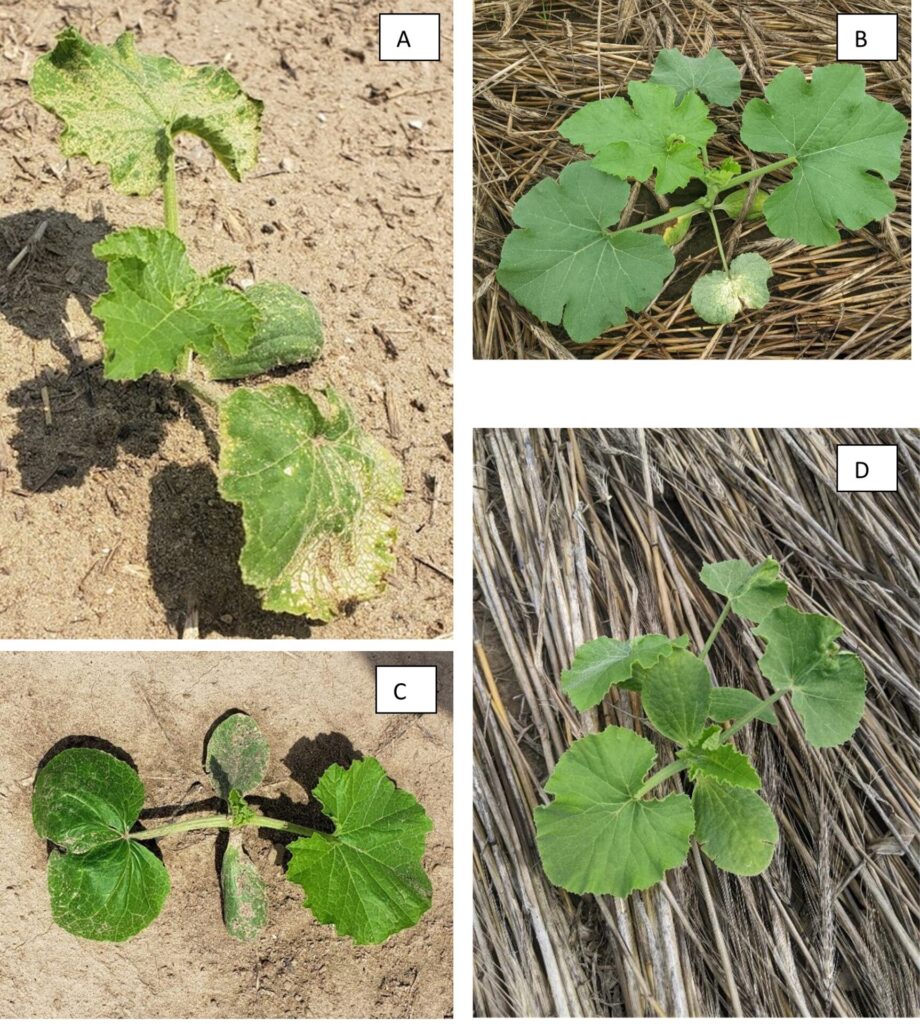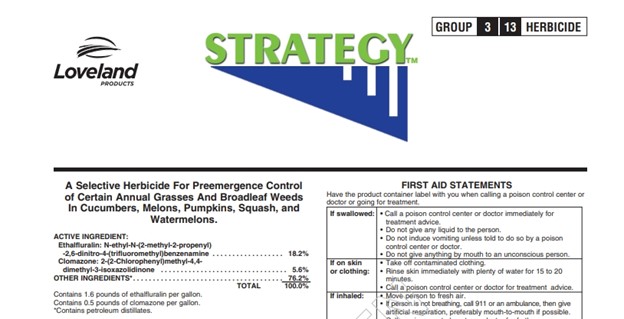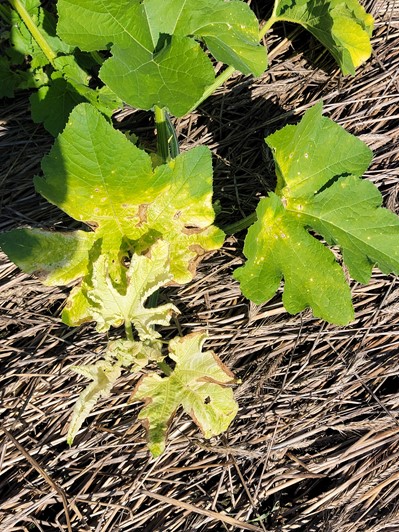Across the state of Indiana and the country, the first pumpkin and winter squash plants of the season are popping up out of the ground. It is a time of great anticipation and usually triggers a series of phone calls and emails to my inbox. Below, I address some of the frequently asked questions about pumpkin weed management at planting and in the early season.
Can I make my own “StrategyTM” herbicide?
Yes, sometimes. StrategyTM is a herbicide that contains a premix of two active ingredients: ethalfluralin (the active ingredient in Curbit® EC) and clomazone (the active ingredient in Command® 3 ME) (Figure 1). Often, pumpkin farmers do not have StrategyTM on hand and would like to tank-mix Curbit® and Command®. This is allowable as long as the label is followed for both products. Because the Command® label explicitly prohibits its use on jack-o-lantern pumpkins, NK530, NK580, Turks Turban, Golden Delicious, banana squashes, and “all other Cucurbita maxima types that have a pink or burnt orange coloration at harvest”, applications of a homemade “Strategy” tank-mix must also follow these restrictions. If you can meet the restrictions of both labels, then the application is allowable. Following mixing order rules, you would add Command® (a microencapsulated formulation) to the tank before adding Curbit® (an emulsifiable concentrate formulation).
Can I apply Dual Magnum® over-the-top of emerged pumpkins?
No, not yet. In 2021, researchers in 10 states, including Indiana, evaluated Dual Magnum® applied over-the-top of 14 and 28-day-old jack-o-lantern pumpkin plants. The results were promising and would allow pumpkin growers to extend their residual weed control later into the season. However, this additional use has not made it onto the label yet. So, using Dual Magnum® this way would constitute an off-label application.
My pumpkins are up and I see some herbicide injury- is this normal?
Yes, it is common to have injury from herbicides applied at planting. The injury typically shows up on the first one or two true leaves and then the plant grows normally. Minor discoloration or misshapenness of the first couple leaves should not be a cause for concern. However, more severe injury or injury into the bush stage of growth is not normal. See Figure 2 for examples of injury symptoms you might see from at-planting herbicides.

Figure 2. Pumpkin seedlings exhibiting injury from (A) Reflex (fomesafen)-treated soil splashing onto pumpkin leaves, (B) Command/Strategy (clomazone) “bleaching” on first true leaf, (C) Dual Magnum® (S-metolachlor) and (D) Curbit/Strategy (ethalfluralin) leaf malformation on the first true leaf (Photo credits: S.L. Meyers).
What are my options for postemergence weed control?
This depends on your production method. Cultivation of small, emerged weeds is an option for bare ground production and row middles of plasticulture production. This is not an option for those growing into terminated cover crops. Sandea® may be used for small broadleaf weeds and sedges. The application window in pumpkins is between the 2-5 true leaf stage until the appearance of the first female flower. In most cases, when we apply Sandea®, we do see some crop injury (stunting and yellowing) and a slight reduction in yield. This risk can be reduced by making a directed application to limit the amount of herbicide landing on the pumpkin plants. Clethodim and sethoxydim herbicides can be broadcast over-the-top of the pumpkins for grass weed control, but they will not control broadleaf weeds or sedges. Both of these products, as well as Sandea®, will require the use of an adjuvant to control emerged weeds. In hotter weather, non-ionic surfactants (NIS) will be less likely to cause crop injury compared with crop oil concentrates (COC). In either case, avoid making an application during the hottest part of the day, which could increase injury from the adjuvant. Finally, glyphosate can be applied between rows with a hooded sprayer for broad-spectrum control of emerged weeds. However, it must not be allowed to contact pumpkins or serious injury could occur (Figure 3).
For more information on pumpkin weed management, consult the Midwest Vegetable Production Guide at mwveguide.org

